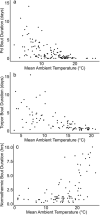Thermally unstable roosts influence winter torpor patterns in a threatened bat species
- PMID: 40242594
- PMCID: PMC11020254
- DOI: 10.1093/conphys/coae014
Thermally unstable roosts influence winter torpor patterns in a threatened bat species
Abstract
Many hibernating bats in thermally stable, subterranean roosts have experienced precipitous declines from white-nose syndrome (WNS). However, some WNS-affected species also use thermally unstable roosts during winter that may impact their torpor patterns and WNS susceptibility. From November to March 2017-19, we used temperature-sensitive transmitters to document winter torpor patterns of tricolored bats (Perimyotis subflavus) using thermally unstable roosts in the upper Coastal Plain of South Carolina. Daily mean roost temperature was 12.9 ± 4.9°C SD in bridges and 11.0 ± 4.6°C in accessible cavities with daily fluctuations of 4.8 ± 2°C in bridges and 4.0 ± 1.9°C in accessible cavities and maximum fluctuations of 13.8 and 10.5°C, respectively. Mean torpor bout duration was 2.7 ± 2.8 days and was negatively related to ambient temperature and positively related to precipitation. Bats maintained non-random arousal patterns focused near dusk and were active on 33.6% of tracked days. Fifty-one percent of arousals contained passive rewarming. Normothermic bout duration, general activity and activity away from the roost were positively related to ambient temperature, and activity away from the roost was negatively related to barometric pressure. Our results suggest ambient weather conditions influence winter torpor patterns of tricolored bats using thermally unstable roosts. Short torpor bout durations and potential nighttime foraging during winter by tricolored bats in thermally unstable roosts contrasts with behaviors of tricolored bats in thermally stable roosts. Therefore, tricolored bat using thermally unstable roosts may be less susceptible to WNS. More broadly, these results highlight the importance of understanding the effect of roost thermal stability on winter torpor patterns and the physiological flexibility of broadly distributed hibernating species.
Keywords: Perimyotis subflavus; roost microclimate; short-term torpor; thermally unstable roosts; white-nose syndrome.
© The Author(s) 2024. Published by Oxford University Press and the Society for Experimental Biology.
Conflict of interest statement
The authors have no conflicts of interest to declare.
Figures




References
-
- Agostinelli C, Lund U (2017) R pack “circular”. Circular Statistics .
-
- Barclay RMR, Kalcounis MC, Crampton LH, Stefan C, Vonhof MJ, Wilkinson L, Brigham RM (1996) Can external radiotransmitters be used to assess body temperature and torpor in bats? J Mammal 77: 1102–1106. 10.2307/1382791. - DOI
-
- Barclay RMR, Lausen CL, Hollis L (2001) What’s hot and what’s not: defining torpor in free-ranging birds and mammals. Can J Zool 79: 1885–1890. 10.1139/z01-138. - DOI
LinkOut - more resources
Full Text Sources

